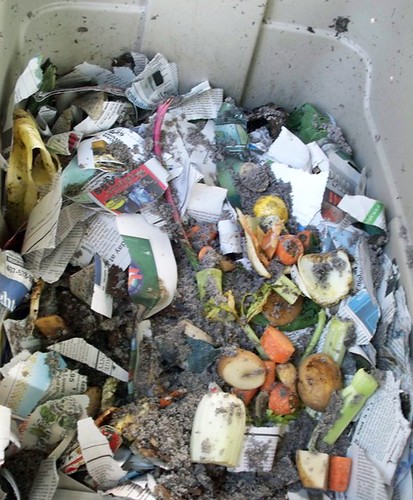Worm Compost Harvest
 |
| Worm Sorting |
Today I finially got around to harvesting the worm castings and making them a new bed. Sorting the worms can get a little tricky. The key is to move the casting/compost around enough so that the worms dig away from the light. This way when you grab a handful of compost at the top of the pile, it shouldnt contain too many worms. The worms should move them selves further and further down as you sort them. Towards the end of the sorting, you will have more worms to separate from the castings/compost. Any material that isnt all the way decomposed, it needs to go back into the new bedding for the worm bin. It will also help start the micro breakdown of the new material/bedding.
 |
| End Result - Sorted Worm Compost/Castings |
Here the castings/compost is alive with tons of micro organisms. My camera is detailed enough to get a good close-up. I found plenty of baby worms and worms of all sizes. I plan on keeping this compost outside for about a month so it can dry out (in the shade). I need to find a good spot so that it doesn't get rained on. Right now its a consistency of clay.
 |
| New Bedding for the worms. |
Im also planning on making some worm tea and using it in my soil and my nft fence post system. If all goes well, It will be the nutrients I use for gutter NFT system in the greenhouse for the greens.
"There are over 4000 species of earthworms but only 3 are considered composting worms. The common names for these three are the "Red Wiggler", "Blue Wiggler" and the "Tiger Worm". Eisendia Fetida is the proper name for the "Red Wiggler" and this worm is more familiar to us in the States.
 |
| Worm Drippings/Tea |
The Eisendia Fetida has been found to be capable of transforming huge quantities of garbage into something very valuable. They have a very big appetite and can eat 1 to 1 ½ times their weight every day. The "Red Wiggler" excreta, known as "castings", and the washing of the worm urine, known as "worm tea" contain plant growth regulators and other substances. This makes them nature's most remarkable form of bio fertilizer and bi-pest agents.
Your "Red Wiggler" population can grow very rapidly. When worms breed, both male and female have reproductive organs. During mating, two worms align themselves in a head to tail position. A thick layer of mucus is produced and the two worms aligned discharge sperm cells, and then separate from each other.
A broad ring forms around each worm's body which receive the eggs and sperm cells as the worm works its body backwards from inside this ring. Eventually, the ring passes over the worms' head to form a cocoon, which house a number of eggs. (this process is much like slipping out of a shirt over our heads.)"
- copied from http://www.ourvitalearth.com/
 |
| New Worm Bedding. I added a little sand to help with the worm digestion. Useful Worm Composting Links: http://www.redwormcomposting.com/ http://www.ourvitalearth.com/ http://www.thewormdude.com/ |
I am very happy that I found your blog. I am going to try and make a worm composting bin system with our 6 year old this year for his homeschool science project. I will be reading and learning from your posts. Thanks for sharing all of your wonderful information and photos!!
ReplyDeleteI have a make shift compost bin set up right now in the yard and it is going great. I plan on building a larger one, I have way too many kitchen scraps to waste...I need to compost more.
Peace and RAW Health,
Elizabeth
Thanks for visiting!
ReplyDeleteThis would be a great science project, but it can get a little messy and disgusting looking. With good ventilation and air circulation, it shouldn't get too stinky.
Im glad to see you composting and teaching the little ones! Its amazing how much these worms can eat. After the micro activity picks up in your bin, the worms have their way with everything, very fast.
Have fun & Enjoy :)